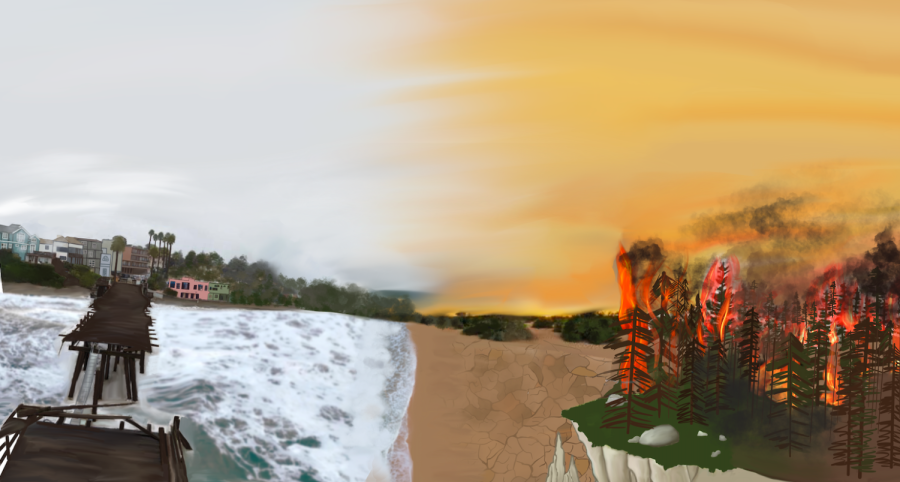California’s climate change causes destruction
Graphic illustrations by Eileen Zhu
From dried reservoirs to flooded households, California’s volatile climate has significantly impacted communities throughout the state.
February 6, 2023
From dried reservoirs to flooded households, California’s volatile climate has significantly impacted communities throughout the state. Due to its unique geographical setting, California is highly susceptible to extreme shifts in climate, frequently resulting in natural disasters intensified by climate change. The consequences of these extreme patterns are reflected in communities struggling with the loss of shelter and food.
Since the 20th century, climate change has become more apparent as a significant factor in countless environmental hazards across the globe. It is among the most prominent issues in today’s sociopolitical environment due to its tremendous potential for world-changing development. As the world continues to warm as more greenhouse gasses accumulate in the atmosphere, catastrophic events are projected to increase rapidly in both rate and intensity.
“I think rising sea levels is a pressing concern,” Conservation Action Association club president Cindy Chou said. “People predict that Venice might be unlivable in 20 years. I think it’s possible that parts of California could be completely underwater due to melting glaciers.”
California is infamous for its dry seasons and long droughts. Prior to the historical levels of rainfall in the first weeks of January 2023, roughly 35% of California was declared as a state of extreme drought. California typically experiences droughts in oscillating periods, with some periods lasting only a few months and others multiple years. 2022 was an exceptionally dry year, resulting in thousands of dried wells important to certain communities for drinking water and the destruction of hundreds of thousands of acres of farmland.
California is also a flood-prone state due to its susceptibility to heavy winter storms and atmospheric rivers — streams of water vapor in the sky. These floods provide nearly half of the annual precipitation in the state, and atmospheric rivers transport 90% of the globe’s water vapor in 10% of the area. The flood that stormed over California in the beginning of 2023 alleviated some of the state’s drought in several areas that have developed over the past three years.
“Drought impacts vary by location as California is a large state, and drought recovery will need to be evaluated on a regional scale and will depend on local water supply conditions,” state climatologist Michael Anderson said. “As a result of the recent storms, the landscape is now wet which allows rivers to flow and plants to grow. Reservoirs were able to collect runoff from the storms to restore storage. Water on the landscape enabled percolation to groundwater which should help in aquifer recovery — a slow process and often requires multiple wet years to fully recover depleted storage.”
These series of storms also have negative impacts, as they have displaced families across the state, demanding extensions of relief resources up to the federal level, including statewide grants. Damage from storms is estimated to cost the government over a billion dollars in reconstruction and resource allocation. Heavy rains also lead to landslides, where an abundance of water seeps into the ground after a long drought, creating an imbalance on hillsides and causing them to move or slide. It can take several months to even out, delaying repairs and hindering recovery.
“I’ve counted at least twenty trees that have fallen on our property,” math teacher and affected resident Jeremy Dybdahl said. “On the way to work, power lines were down and I didn’t get to come to work because the road was closed. We lost a lot of our property due to the wind storms and a lot of things were ruined in the water.”
On the opposite side of the weather spectrum, wildfires are a regular occurrence in California, with the state’s most devastating wildfire occurring in August 2020. These events, sparked by lightning, heat from the sun and human negligence like leftover campfires or gender reveal parties, consumed over one million acres of land important to communities and ecosystems. However, only 5% of California wildfires are caused by lightning while 95% are instead by human causes. Wildfires have burned 4% of the land’s total area over the past five years, and the increasing wildfires hav been linked to climate change. California’s drought has caused higher average temperatures throughout the state, leading to higher chances of wildfires spreading than in the past.
“A warmer atmosphere dries out the landscape faster and can create more
opportunities for windy conditions,” Anderson said. “This can lead to rapid fire development leading to larger fires which can burn more intensely given the drier vegetation.”
In response to recent flooding, local and federal governments alike have taken action to support those displaced by storms with resources and moral influence. California governor Gavin Newson and President Joe Biden have visited storm-affected areas to assess damages and encourage the bolstering of emergency responses across the state. American Red Cross workers stationed in the state have also been called to action and worked tirelessly to further support damaged communities.
“In the Paris agreement, they set the goal of wanting to keep Earth’s warming under 1.5 degrees Celsius,” Chou said. “But many scientists think it’s not possible, given where we’re currently headed. I think if we want to remain under 1.5 degrees, a lot has to be done with government policy, like working with huge coal mining factories or fossil fuel companies.”
As the dust settles from the passing storms, California’s climate is projected to return to a consistent temperature range throughout the rest of the year. Despite the alleviation of some of the drought-related issues that the state has endured over the last few dry years, California will likely continue to remain in a drought.





























































